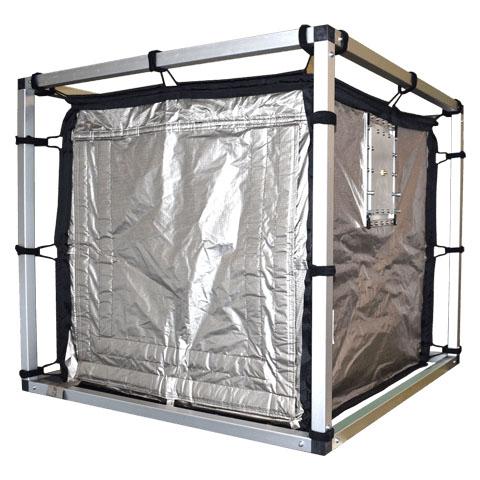Checking Out the Flexibility of Secured Test Enclosures in Different Digital Testing Scenarios
In the realm of electronic screening, the significance of protected test units can not be overemphasized. These specialized enclosures play an important role in ensuring the accuracy and integrity of examination results across a range of testing situations. From electro-magnetic compatibility testing to signify honesty analyses and beyond, protected examination units provide a level of accuracy and control that is vital in today's complicated digital landscape. As we discover their convenience in numerous testing applications, a deeper understanding of their influence on the precision and effectiveness of screening processes arises, dropping light on the pivotal duty they play in ensuring the quality and performance of electronic devices.
Significance of Secured Test Rooms
The importance of shielded test enclosures in digital testing can not be overstated because of their essential duty in ensuring accurate and dependable test outcomes. Protected examination rooms supply a controlled testing atmosphere by stopping outside electro-magnetic disturbance from affecting the performance of electronic devices under examination. This protecting is necessary for keeping the stability of the screening procedure, specifically when managing delicate elements or signals that can be easily affected by outside aspects.

Essentially, the importance of secured test rooms hinges on their capacity to create a secure and interference-free testing atmosphere, ultimately adding to the accuracy, dependability, and honesty of electronic screening processes.

Applications in Electromagnetic Compatibility Screening
With the fundamental role of protected test units in making sure trustworthy and precise electronic testing results developed, their application in electromagnetic compatibility screening emerges as an essential element in confirming the resilience of electronic tools against exterior electromagnetic disturbance. In electro-magnetic compatibility testing, protected examination units play a pivotal duty in producing controlled screening environments that imitate real-world electro-magnetic problems. Overall, secured test rooms are indispensable tools in electromagnetic compatibility screening, providing a controlled atmosphere for exact analysis and validation of digital tools' strength against electro-magnetic disturbance.
Enhancing Signal Stability Checking
Just how can secured examination units boost the accuracy of signal stability testing in electronic gadgets? Secured examination units play an important function in improving signal stability screening by giving a regulated environment that minimizes external disturbance and sound. These units develop a secured room that separates the device under test from outside magnetic fields, guaranteeing that the signals being measured precisely stand for the gadget's true performance.
By reducing electro-magnetic disturbance, secured examination rooms help engineers attain extra reliable and specific measurements of signal stability specifications such as rise jitter, crosstalk, and time. This accuracy is vital for assessing the quality of high-speed electronic signals and making certain that electronic gadgets satisfy sector criteria for click to investigate efficiency and dependability.
Furthermore, secured rooms enable designers to replicate real-world operating conditions by developing a regulated electromagnetic setting. This ability is particularly valuable for signal honesty testing in tools that are sensitive to exterior electromagnetic disturbance, such as wireless interaction systems and high-speed data networks.
Convenience in IoT Gadget Testing
Convenience plays an essential duty in successfully testing IoT devices for their capability and performance throughout varied situations. IoT tools encompass a large range of interconnected gadgets, from sensing units and actuators to intricate smart systems. Testing the capability and efficiency of these tools needs a versatile technique that can adjust to the different communication protocols, regularities, and environmental conditions that IoT gadgets run in.
Shielded examination rooms use the versatility needed for testing IoT tools here by supplying a regulated testing environment that can replicate real-world problems while making certain precise and reputable outcomes. These enclosures can shield versus electro-magnetic interference, mimic different RF atmospheres, and supply a regulated temperature level and moisture setup, enabling thorough testing of IoT devices in different scenarios.
Moreover, the convenience of protected examination rooms allows designers to check IoT tools under different network conditions, power degrees, and signal toughness, ensuring that the tools can do ideally in varied IoT release situations. By using protected test rooms for IoT device testing, designers can confirm the performance, performance, and reliability of these devices throughout a large range of real-world problems, inevitably leading to the development of effective and robust IoT services.
Role in RF and Wireless Screening
Protected test rooms play a vital function in guaranteeing the precision and dependability of RF and cordless screening for electronic tools (rf shielded test enclosure rochester). These rooms provide a separated screening setting devoid of external disturbance, enabling engineers to gauge the true efficiency of RF circuits and wireless interaction systems. By producing a secured room, these rooms prevent signals from running away and block external signals from going into, enabling specific measurements and regular outcomes
In RF screening, shielded examination enclosures are crucial for assessing the efficiency of antennas, transmitters, receivers, and other RF parts. The controlled setting within the enclosure assists in identifying the radiation patterns, signal strength, and regularity reaction of RF devices accurately. In cordless screening scenarios, these rooms replicate real-world conditions while guaranteeing that signals continue to be had within the YOURURL.com test setup, without triggering disturbance to external systems.
Conclusion
Finally, protected examination rooms play an essential role in different electronic testing situations such as electro-magnetic compatibility screening, signal honesty screening, IoT tool screening, and RF and wireless testing. Their flexibility permits the precise and trusted testing of electronic devices in regulated settings, making certain optimal performance and functionality. Overall, shielded examination units are important tools in the field of electronics screening, supplying a protected atmosphere for exact dimensions and analysis.
